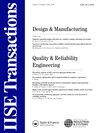Ontology-guided Attribute Learning to Accelerate Certification for Developing New Printing Processes
IF 2
3区 工程技术
Q3 ENGINEERING, INDUSTRIAL
引用次数: 0
Abstract
AbstractIdentifying printing defects is vital for process certification, especially with evolving printing technologies. However, this task proves challenging, especially for micro-level defects necessitating microscopy, which presents a scalability barrier for manufacturing. To address this challenge, we propose an attribute learning methodology inspired by human learning, which identifies shared attributes among seen and unseen objects. First, it extracts defect class embeddings from an engineering-guided defect ontology. Then, attribute learning identifies the combination of attributes for defect estimation. This approach enables it to recognize previously unseen defects by identifying shared attributes, even those not included in the training dataset. The research formulates a joint optimization problem for learning and fine-tuning class embedding and ontology and solves it by integrating natural language processing, metaheuristics for exploration and exploitation, and stochastic gradient descent. In a case study involving a direct-ink-writing process for creating nanocomposites, this methodology was used to learn new defects not found in the training data using the optimized ontology. Compared to traditional zero-shot learning, this ontology-based approach significantly improves class embedding, outperforming transfer learning in one-shot and two-shot learning scenarios. This research represents an early effort to learn new defect concepts, potentially reducing the need for extensive measurements in defect identification.Keywords: Additive ManufacturingAttribute learningOntologyDefect identificationProcess certificationDisclaimerAs a service to authors and researchers we are providing this version of an accepted manuscript (AM). Copyediting, typesetting, and review of the resulting proofs will be undertaken on this manuscript before final publication of the Version of Record (VoR). During production and pre-press, errors may be discovered which could affect the content, and all legal disclaimers that apply to the journal relate to these versions also. Additional informationNotes on contributorsTsegai O. YhdegoTsegai O. Yhdego is a researcher in Industrial Engineering pursuing a Ph.D. at Florida A&M University. His academic journey includes a BSc. in Electrical and Electronics Engineering (2015) from Eritrea Institute of Technology and an MSc. in Mechatronic Engineering (2019) from The Pan African University Institute for Basic Sciences, Technology and Innovation. His research focuses on developing small-sample machinelearning algorithms, specializing in ontology-based federated learning, emphasizing data security and collaborative machine learning. He has also contributed to the aviation industry, developing ML models to forecast flight delay and delay impact.Hui WangHui Wang is an associate professor of industrial engineering at the Florida A&M University-Florida State University College of Engineering and a member of the HighPerformance Materials Institute (HPMI). His research has been focused on (i) data modeling and analytics to support quality control for manufacturing processes, including small-sample learning under an interconnected environment, and (ii) optimization of manufacturing system design and supply chain. He received his PhD in industrial engineering from the University of South Florida and an MSE in mechanical engineering from the University of Michigan.Zhibin YuZhibin Yu is an associate professor of industrial engineering at the Florida A&M University-Florida State University College of Engineering and a member of the HighPerformance Materials Institute (HPMI). His research has been focused on nanomaterials synthesis and processing for printing electronics. He received his PhD in materials science and engineering from the University of California, Los Angeles.Hongmei ChiHongmei Chi is a professor of computer and information sciences at Florida A&M University. Her research focuses on areas of applied cybersecurity, mobile health privacy, Monte Carlo and quasi-Monte Carlo, and data science. She received her PhD in computer science at Florida State University.识别印刷缺陷对于过程认证至关重要,特别是随着印刷技术的发展。然而,这项任务被证明是具有挑战性的,特别是对于需要显微镜的微观缺陷,这为制造提供了可扩展性障碍。为了解决这一挑战,我们提出了一种受人类学习启发的属性学习方法,该方法可以识别可见和不可见对象之间的共享属性。首先,它从工程引导的缺陷本体中提取缺陷类嵌入。然后,属性学习识别用于缺陷估计的属性组合。这种方法使它能够通过识别共享属性来识别以前未见过的缺陷,甚至那些未包含在训练数据集中的属性。本研究提出了学习微调类嵌入与本体的联合优化问题,并结合自然语言处理、元启发式探索开发、随机梯度下降等方法进行解决。在一个涉及直接墨水书写过程的案例研究中,使用优化的本体学习训练数据中未发现的新缺陷。与传统的零次学习相比,这种基于本体的方法显著改善了类嵌入,在一次和两次学习场景下优于迁移学习。这项研究代表了学习新缺陷概念的早期努力,潜在地减少了在缺陷识别中广泛测量的需要。关键词:增材制造属性学习本体缺陷识别过程认证免责声明作为对作者和研究人员的服务,我们提供此版本的接受稿件(AM)。在最终出版版本记录(VoR)之前,将对该手稿进行编辑、排版和审查。在制作和印前,可能会发现可能影响内容的错误,所有适用于期刊的法律免责声明也与这些版本有关。作者简介:作者简介:作者是佛罗里达农工大学工业工程专业的研究人员,正在攻读博士学位。他的学术生涯包括获得理学士学位。2015年获得厄立特里亚理工学院电气与电子工程专业硕士学位。泛非大学基础科学、技术与创新研究所机电工程学士学位(2019)。他的研究重点是开发小样本机器学习算法,专攻基于本体的联邦学习,强调数据安全和协作机器学习。他还为航空业做出了贡献,开发了机器学习模型来预测航班延误和延误影响。王辉是佛罗里达农工大学-佛罗里达州立大学工程学院工业工程副教授,也是高性能材料研究所(HPMI)的成员。他的研究主要集中在(i)数据建模和分析,以支持制造过程的质量控制,包括在互联环境下的小样本学习,以及(ii)制造系统设计和供应链的优化。他在南佛罗里达大学获得工业工程博士学位,在密歇根大学获得机械工程硕士学位。余志斌,佛罗里达农工大学-佛罗里达州立大学工程学院工业工程副教授,高性能材料研究所(HPMI)成员。他的研究重点是纳米材料的合成和印刷电子的加工。他在加州大学洛杉矶分校获得材料科学与工程博士学位。池红梅是佛罗里达农工大学计算机与信息科学教授。她的研究主要集中在应用网络安全、移动健康隐私、蒙特卡罗和准蒙特卡罗以及数据科学领域。她在佛罗里达州立大学获得计算机科学博士学位。
本文章由计算机程序翻译,如有差异,请以英文原文为准。
求助全文
约1分钟内获得全文
求助全文
来源期刊

IISE Transactions
Engineering-Industrial and Manufacturing Engineering
CiteScore
5.70
自引率
7.70%
发文量
93
期刊介绍:
IISE Transactions is currently abstracted/indexed in the following services: CSA/ASCE Civil Engineering Abstracts; CSA-Computer & Information Systems Abstracts; CSA-Corrosion Abstracts; CSA-Electronics & Communications Abstracts; CSA-Engineered Materials Abstracts; CSA-Materials Research Database with METADEX; CSA-Mechanical & Transportation Engineering Abstracts; CSA-Solid State & Superconductivity Abstracts; INSPEC Information Services and Science Citation Index.
Institute of Industrial and Systems Engineers and our publisher Taylor & Francis make every effort to ensure the accuracy of all the information (the "Content") contained in our publications. However, Institute of Industrial and Systems Engineers and our publisher Taylor & Francis, our agents, and our licensors make no representations or warranties whatsoever as to the accuracy, completeness, or suitability for any purpose of the Content. Any opinions and views expressed in this publication are the opinions and views of the authors, and are not the views of or endorsed by Institute of Industrial and Systems Engineers and our publisher Taylor & Francis. The accuracy of the Content should not be relied upon and should be independently verified with primary sources of information. Institute of Industrial and Systems Engineers and our publisher Taylor & Francis shall not be liable for any losses, actions, claims, proceedings, demands, costs, expenses, damages, and other liabilities whatsoever or howsoever caused arising directly or indirectly in connection with, in relation to, or arising out of the use of the Content. Terms & Conditions of access and use can be found at http://www.tandfonline.com/page/terms-and-conditions .
 求助内容:
求助内容: 应助结果提醒方式:
应助结果提醒方式:


